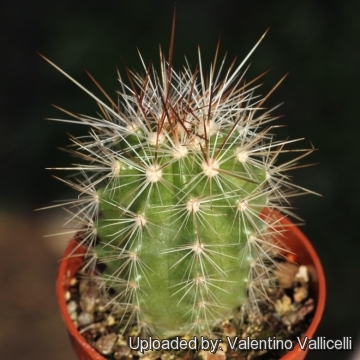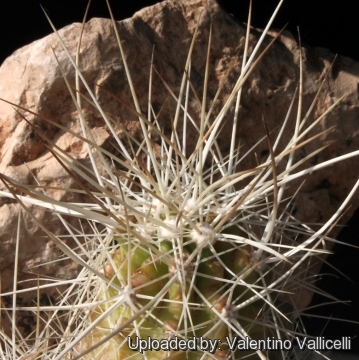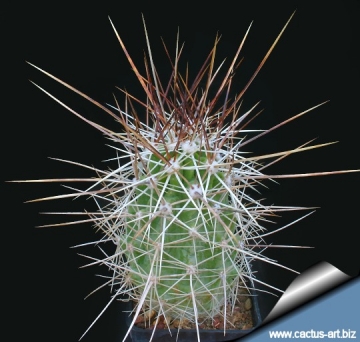
Echinocereus enneacanthus Photo by: Valentino Vallicelli
SB700 (Collector: Steven Brack) Locality: Cuchillo, Coahuila, Mexico, this is a form with long massive spines.
Origin and Habitat: Echinocereus enneacanthusSN|7930]]SN|7930]] is common and wide-spread species occuring in central, north and north-east of Mexico (Sonora, Chihuahua, Durango, Nuevo León, Tamaulipas, San Luis Potosí, Coahuila and Zacatecas), New Mexico, and Texas.
Altitude: (0-)600-1800 metres above sea level.
Habitat: Chihuahuan desert scrub and grasslands, on mineral and sandy-loamy limestone soils, sometimes clay loam soils, on flats, washes or rarely rocky or gravelly slopes. In the same area it is possible to find several cactus species like: Echinocereus stramineusSN|5533]]SN|7817]], Echinocereus chisoensisSN|17778]]SN|17778]], Echinocereus dasyacanthusSN|7817]]SN|5533]], Mammillaria lasiacanthaSN|9075]]SN|9075]] and Lophophora viridiscens. Echinocereus enneacanthusSN|7930]]SN|7930]] is abundant, and is not affected by any major threats.
Synonyms:
See all synonyms of Echinocereus enneacanthus
Common Names include:
ENGLISH: Strawberry Hedghog Cactus, Green Strawberry Hedgehog, Banana Cactus, Alicoche, Smallspine Pitaya, Pitaya, Prostrate Hedgehog Cactus, Purple Pitaya, Strawberry Cactus, Alicoche Banana Cactus, Green Strawberry, Hedghog Cactus, Cob Cactus, Prostrate Hedgehog
SPANISH (Español): Órgano-pequeño, Alicoche Real, Pitaya
Description: Echinocereus enneacanthusSN|7930]]SN|7930]] is a caespitose cactus forming dense or lax clumps either loose decumbent, or erect with 20-100(-500) branches, usually branching before flowering. There appears to be quite a variation in spination, at least in number and length of spines. Two subspecies are recognized, the nominate form and subsp. brevispinus.
Stems: Cylindrical, the longest sometimes prostrate, 5-14 cm diameter up to over 100 cm long (but usually much shorter). The stems of this species are soft or flaccid, pale to bright green and often remain wrinkled.
Ribs: 7-12 with uninterrupted but prominent warty crests.
Areoles: Circular 18-52 mm apart.
Radial spines: 5-9 per areole, 25-45 mm long, straight or slightly curved, needle-like, more or less flattened, bulbous at the base, brownish, often tipped or banded with darker brown.
Central spines: 1-5 per areole, 55-95 mm long, divergent, porrect, flattened, stout, and slightly curved, opaque, white, tan, brown or grey, often nearly black.
Flowers. Funnelform 7-11 cm in diameter, purple-red to pink in varying shades with deep reddish throat, and diurnal. Filaments greenish to pink. Anthers yellow. Stigma green. Style whitish.
Blooming season: It flowers in early spring (April through June in habitat) during mid-morning. Flowers close at night and reopen for 2-4 days. The fruits ripen in late summer.
Fruit: Round to ovoid pale yellow-green or dull reddish, , maturing to bright red, 20-30 mm, pulp white or pale pink. The fruit is edible. After the spines are removed from the green-brown flesh of the fruit, it can be eaten and tastes similar to strawberry, hence the name strawberry cactus.
Seeds: 1,0-1,4 mm, black irregular, globular, or ovoid tuberculate.
Bibliography: Major references and further lectures
1) Goettsch, B.K., Gómez-Hinostrosa, C., Heil, K., Terry, M. & Corral-Díaz, R. 2013. Echinocereus enneacanthus. In: IUCN 2013. "IUCN Red List of Threatened Species." Version 2013.2. <www.iucnredlist.org>. Downloaded on 16 January 2014.
2) Forrest Shreve, Ira Loren Wiggins “Vegetation and Flora of the Sonoran Desert” Volume 1 Stanford University Press, 1964
3) Edward Anderson “The Cactus family” Timber Press, Incorporated, 2001
4) James Cullen, Sabina G. Knees, H. Suzanne Cubey "The European Garden Flora Flowering Plants: A Manual for the Identification of Plants Cultivated in Europe, Both Out-of-Doors and Under Glass" Cambridge University Press, 11/Aug/2011
5) David R Hunt; Nigel P Taylor; Graham Charles; International Cactaceae Systematics Group. "The New Cactus Lexicon" dh books, 2006
6) Urs Eggli, Leonard E. Newton: “Etymological Dictionary of Succulent Plant Names” Springer, Berlin/Heidelberg 2010
7) Ulises Guzmán, Salvador Arias, Patricia Dávila "Catálogo de cactáceas mexicanas." Universidad Nacional Autónoma de México, Mexiko-State 2003
8) Delena Tull “Edible and Useful Plants of Texas and the Southwest: A Practical Guide” University of Texas Press, 1999
9) Brian Loflin, Shirley Loflin “Texas Cacti: A Field Guide” Texas A&M University Press, 26/Oct/2009
 Echinocereus enneacanthus Photo by: Valentino Vallicelli
Echinocereus enneacanthus Photo by: Valentino Vallicelli Echinocereus enneacanthus Photo by: Valentino Vallicelli
Echinocereus enneacanthus Photo by: Valentino Vallicelli Echinocereus enneacanthus Photo by: Cactus Art
Echinocereus enneacanthus Photo by: Cactus Art Echinocereus enneacanthus Photo by: Valentino Vallicelli
Echinocereus enneacanthus Photo by: Valentino Vallicelli Echinocereus enneacanthus Photo by: Cactus Art
Echinocereus enneacanthus Photo by: Cactus Art Echinocereus enneacanthus Photo by: Cactus Art
Echinocereus enneacanthus Photo by: Cactus ArtCultivation and Propagation: Rot easily it is sensitive to overwatering (rot prone) needs a very good drainage to avoid rotting, Keep drier and cool in winter. Need full sun. Very cold resistant It can withstand freezing temperatures but not too much water (resistant to approx -12C or less for short periods of time)
Propagation: Cuttings that are left out to callus off before planting ; Also can be grown from seeds.

















